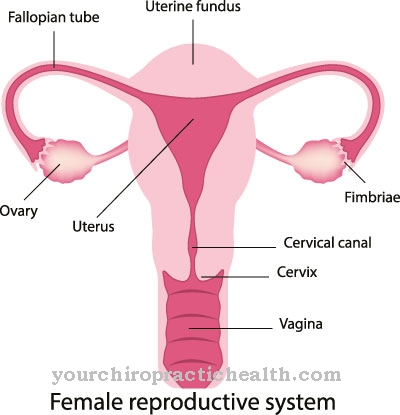At a Neuroma it is a tumor that grows from Schwann's cells and is benign. Depending on the location of the tumor, the symptoms can vary greatly from case to case; However, pain and nerve failure are particularly common. The primary treatment options are surgical removal of the neuroma and radiation therapy.
What is a neuroma?

© Kzenon - stock.adobe.com
The Neuroma is a specific type of tumor and grows from Schwann cells. This type of glial cell grows in a spiral around the extension of the nerve cells, creating an electrically insulating layer, which increases the speed of signal transmission. Neuromas that develop in these Schwann cells therefore impair the functioning of the respective nerve.
Most people are between 40 and 60 years old; In principle, however, the neuroma can develop in any age group. Because of its benign nature, it is also known as benign peripheral nerve sheath tumor (BPNST). Other names for the neurinoma are: Schwannoma, Schwann cell tumor and neurolemmoma or neurilemmoma.
In very rare cases (less than one percent) the benign neuroma can turn into a malignant neurofibrosarcoma. Arms and legs are particularly often affected by neurofibrosarcoma, while the neurinoma mainly occurs in the head and neck.
causes
Like all tumors, the neuroma is also caused by new growths in the affected tissue. With neurofibromatosis type 2, the likelihood of developing a neurinoma is significantly increased. The hereditary disease leads to the formation of tumors in the brain, the neoplasms mainly grouping around the vestibulocochlear nerve.
Furthermore, in many cases the spinal cord and other cranial nerves have other tumors. Malformations of the eyes, skin changes and abnormalities of the central nervous system as a whole are also common in type 2 neurofibromatosis. In addition to the general symptoms of neuromas and, if applicable, acoustic neuromas, there are other symptoms associated with this disease that can be traced back to other tumors.
Doctors differentiate between two sub-forms of neurofibromatosis type 2, the Feiling-Gardner type only appearing from the age of 20 and characterized by slowly growing, central tumors, whereas the disease onset in the Wishart type is before the age of 20 and this sub-form leads to many rapidly growing tumors.
More rarely, neuromas are a side effect of neurofibromatosis type 1; there, however, they occur statistically more often and the disease is overall more common than type 2. In addition to neurofibromas, café-au-lait spots and Lisch nodules in the iris are characteristic features of type 1 neurofibromatosis.
Symptoms, ailments & signs
Since the neuroma can form in different places in the nervous system, the appearance of the disease is very diverse. Often pain is one of the symptoms; which body area is affected depends on the damaged nerve pathways.
The nerve from whose Schwann cells the neurinoma grows may no longer function at all. In this context, paralysis can occur.Typically, symptoms are slow to manifest and increase in size and severity as the neuroma often grows slowly.
The acoustic neuroma is a specific form of schwannoma. It is a neuroma that grows on the vestibulocochlear nerve. The 8th cranial nerve innervates the inner ear and is important for hearing as well as for the sense of balance.
The acoustic neuroma manifests itself in acoustic complaints such as tinnitus and hearing problems as well as in balance disorders and dizziness. Other possible symptoms include nausea, vomiting, numbness of the face, facial paralysis, decreased sensitivity to pressure and touch in the external ear canal, double vision, ear pain and headache.
Diagnosis & course of disease
On the basis of the clinical picture, neurologists can often roughly narrow down the probable cause of the nervous disorder that leads to the individual complaints. An examination using magnetic resonance imaging (MRI) or other imaging methods makes the tumor visible and can also show other causes and factors if necessary. Very small new formations that do not yet cause any restrictions cannot always be recognized because of the limited resolution of the imaging.
Complications
Although the neuroma is a benign and slowly growing tumor, it can cause long-term complications that require surgical removal of the tumor. If the tumor is still small, there are usually no symptoms. However, larger neuromas often displace neighboring nerves, which leads to the corresponding health problems.
If the neuroma is located in the lumbar spine, chronic back pain occurs due to the compression of neighboring nerves, which radiate into the legs. If the tumor continues to grow, the muscle supplied by the nerve in question may become weak. If the neuroma is in the cervical spine, long-term chronic pain and sensitivity disorders in this area that radiate into the arms occur.
A neuroma in the spinal canal can even lead to paraplegia. There is not much space in the spinal canal, so that in extreme cases, the displacement of the neighboring nerves can lead to their functional failure. If there is a neuroma in the finger or hand, the compression of adjacent nerves can cause tingling and numbness there.
When the auditory nerves are affected, hearing loss can sometimes result in deafness, dizziness and tinnitus. A dangerous complication is the increase in intracranial pressure up to the congestion of the liquor due to the narrowing of the brain stem. In very rare cases malignant degeneration of the tumor occurs.
When should you go to the doctor?
A doctor should be consulted as soon as the first diffuse irregularities of the organism appear. Since the neuroma is a tumor, caution should always be exercised. In the case of benign tumors, too, a diagnosis must be carried out as quickly as possible so that malignant diseases can be ruled out. Any swelling, pain, or the formation of ulcers on the body should be presented to a doctor. If there are movement restrictions, general mobility disorders or unsteady gait, a doctor is required.
Loss of the functionality of the sensory organs, nausea, vomiting, sensory disorders or numbness of the skin should be examined and treated. If the person has a change in vision or hearing, there is cause for concern. Double vision, decreased hearing, ear pain, headache, or headache are warnings from the body that should be followed up. Consultation with a doctor is necessary as soon as paralysis of the face, disorders of balance and hypersensitivity to touch stimuli occur.
A neurinoma is characterized by a slow increase in the existing symptoms. This leads to a creeping malaise, a decrease in performance and a general feeling of illness. If the patient's condition does not improve, he or she should discuss the observations with a doctor so that the cause can be clarified.
Treatment & Therapy
Immediate action is not required in every case. Neuromas typically develop slowly and sometimes allow the practitioner to observe the behavior of the tumor before deciding on the type of therapy. The potential treatment risks also play a role in this consideration.
As with all therapeutic approaches, the individual weighing up of costs and benefits for the respective patient is decisive here; a general judgment is not possible. Doctors can perform surgery to remove the neuroma to prevent further growth of the tumor and thus the spread of symptoms.
However, the neuroma grows from the Schwann cells, which electrically isolate the affected nerve cell. Therefore, the surgeon may have to remove part of the nerve with the tumor, which can lead to the symptoms that have already occurred.
After removal, a thorough histological examination provides further information about the type of tumor. Radiation therapy is another option for treating neuroma, where ionized radiation acts on the affected tissue. Radiation dose and duration of treatment vary depending on the patient.
Outlook & forecast
Since neuromas are usually benign, the prognosis is generally very good. Most tumors can be surgically removed without any problems. This also applies to advanced or larger neuromas. In a few cases there are complications that can lead to consequential damage. However, some of these restrictions are short-lived. Hearing disorders are the most common. Disturbances of the equilibrium nerve also occur extremely rarely.
A few weeks after the procedure, most people are usually completely healthy again. If the neuroma has been completely removed in the course of surgery, it will usually not return. The life expectancy of those affected is normal. Seldom parts of the tumor cannot be surgically removed. In these cases it is possible for a relapse to occur. The treatment of such a tumor capsule by radiation is often successful. In about 1% of patients, the neurinoma develops into a malignant neurofibrosarcoma.
Without treatment, the prognosis is much worse. The neuroma often continues to grow and increases intracranial pressure, which can be dangerous for those affected. The earlier the tumor is treated, the better the prospects for treatment.
prevention
In connection with neurofibromatosis of types 1 and 2, neurinomas often develop. Since both forms are genetic diseases, those affected can take this into account when planning a family.
Aftercare
Follow-up care for neuromas is closely coordinated with the treating physicians, but often also with physiotherapists, speech therapists, occupational or sports therapists. It is important to regularly see the radiologist, who can use images to check whether a relapse has occurred.
The tumor has often caused damage that continues to cause symptoms after its removal. Limb sensory disorders or speech disorders, for example, are treated by the relevant therapist. These often give the patient exercises that can be practiced at home as part of the aftercare.
Psychological support is also often very important for those affected in aftercare. The knowledge of the tumor disease and the fear of a possible recurrence can often be managed much better by talking to friends and family as well as the distraction of social contacts. In this context, self-help groups are often a particularly helpful component in individual follow-up care for neuromas.
People who suffer from the same or a similar illness bring a special understanding to the exchange of experiences and have a whole range of practical tips ready for those seeking advice and help. The mental state can also be stabilized by relaxation methods such as autogenic training or progressive muscle relaxation, as well as attending yoga courses.
You can do that yourself
A malignant neuroma must always be treated by a doctor. The growth must be removed by surgery or radiation or chemotherapy in order to avoid degeneration and other complications. For a benign neuroma, therapy can be supported by a range of self-help measures and home remedies.
General measures such as a change in diet and moderate exercise have proven effective. Avoiding salt and gluten can have a positive effect on the growth of the overgrowth. Caffeine, alcohol and sugar should also be avoided, as these substances put additional stress on the body.
After a surgical procedure, rest and rest. The sick person should not expose himself to unnecessary stress and must care for the surgical wound according to the doctor's instructions. If inflammation or bleeding occurs, the doctor must be informed. Finally, it is important to regularly go to cancer screening. If a relapse is suspected, the patient must call in the doctor and have the unusual symptoms clarified. A neuroma must always be clarified by a doctor, because it is not possible to treat the causes yourself.


.jpg)










.jpg)

.jpg)
.jpg)











.jpg)